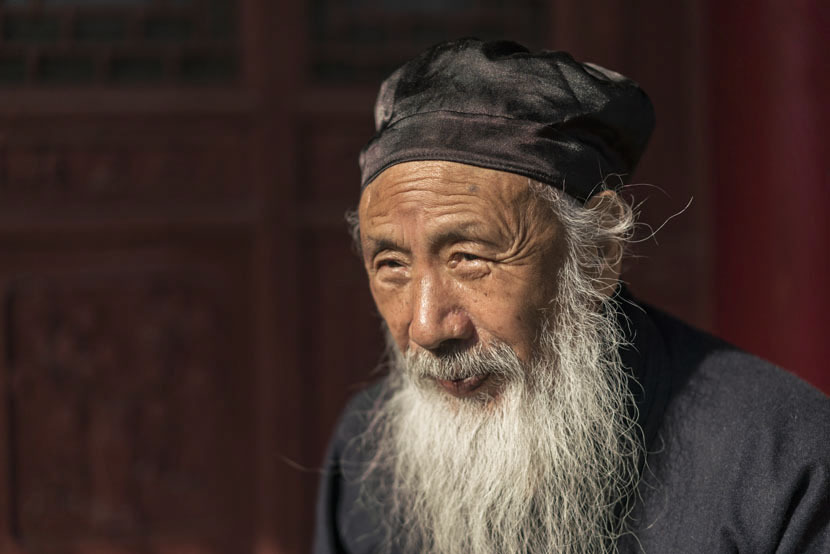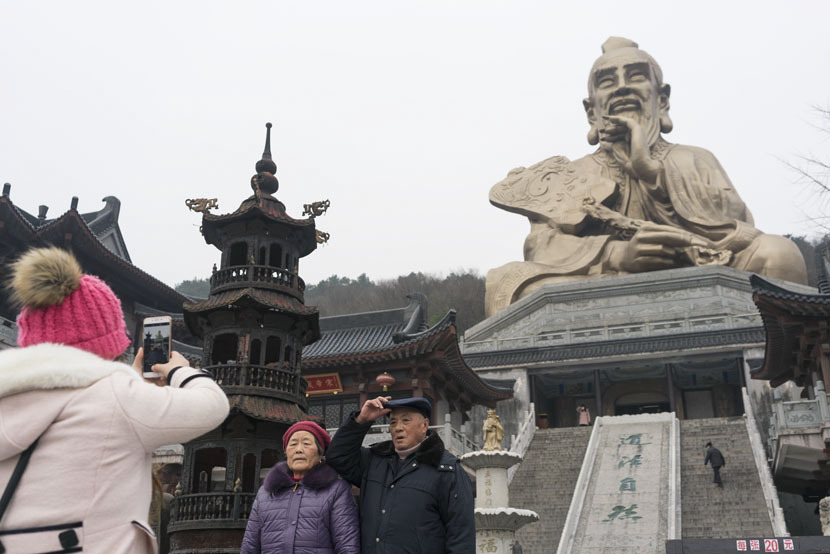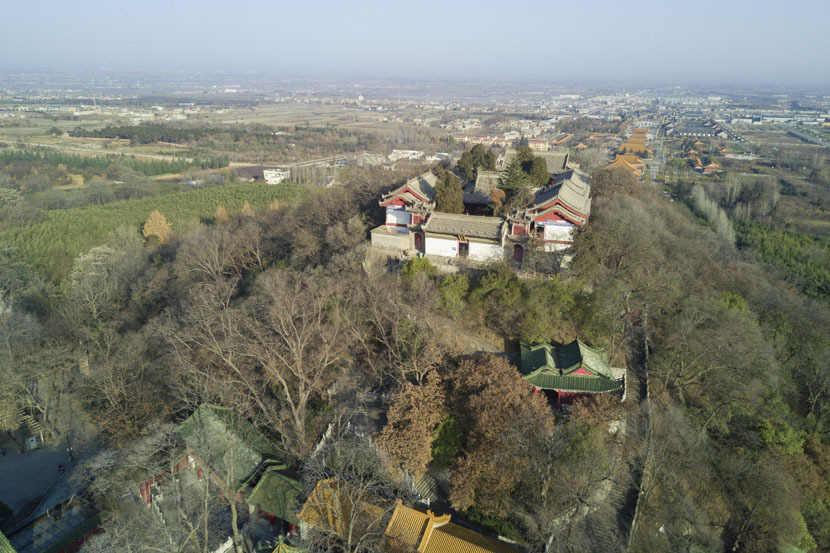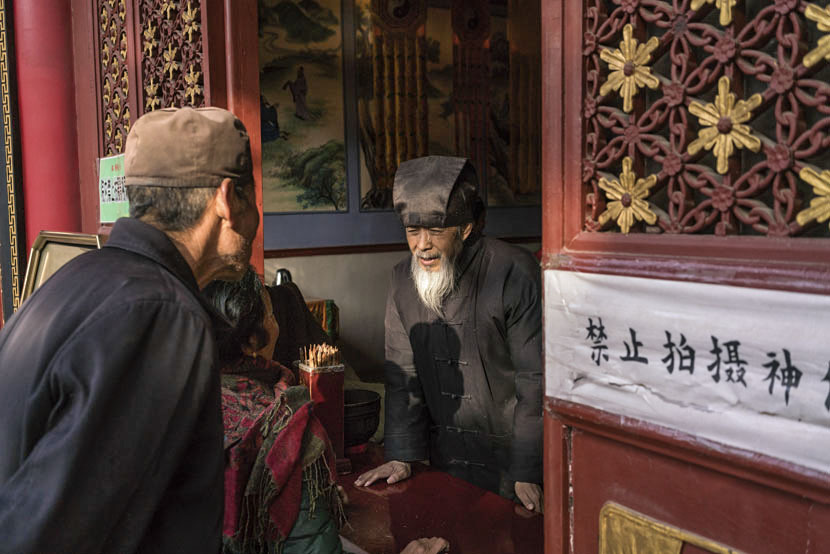Can You See Any Connection Between Taoism and the Environmental Movement Elaborate
On a dank winter morning in Shaanxi, northwest China, rays of sunlight warmed the wrinkled face of Ren Farong, the sometime president of the Chinese Taoist Association. His long white beard bobbed up and downward every bit he spoke.
"In the past, people were pure and honest, and they protected the environment," Ren said from his wicker chair in the courtyard of Louguantai Taoist Temple. Information technology was here in the fourth century that Lao-tzu wrote the Tao Te Ching, the text that serves every bit the foundation of Taoism.
Under the emerald roofs of Louguantai, monks with long hair tied into buns saunter past pine copse and firs, paying their respects to the sage and their gods in gold shrines, interrupted only past the occasional ringing of bells.
But 70 kilometres from this tranquil enclave lies Shaanxi's capital, Eleven'an, a city of about ix million people. At that place, luxury cars zilch by loftier-cease shopping malls, coal plants belch toxic fumes into the air, and factories dump waste into waterways.
Ren believes that greed and selfishness accept destroyed the world's natural balance. Every bit a Taoist, he follows the wu wei — a spiritual tenet that literally means "non-doing," and is oft explained equally letting things follow their natural flow. Merely the environmental deposition Ren and other Taoists were seeing year afterwards twelvemonth horrified them then much that they decided to do something out of graphic symbol: They agreed to have action.
More than two,500 years later on Lao-tzu wrote his classic tome at Louguantai, Prc'south leading Taoists convened at the same spot to pen the Qinling Agreement, in which they pledged to protect the environment and become quiet champions of a new "green revolution" which they called the "Daoist Ecological Protection Network."
Since the network'due south founding in 2006, around 120 temples have joined. Some use biofuels and solar-powered lighting; others found copse to prevent erosion and organise volunteers to pick up litter. Posters and signs prominently displayed at the temples remind visitors of the importance of nature.
"Taoist beliefs emphasise respecting and protecting nature, all in the pursuit of harmony between the homo beings and the surround," said Ren, for whom becoming ane of the quiet, inconspicuous leaders of a new green movement in Prc seemed a natural fit.

Ren Farong, ane of the highest-ranking Taoist masters in Prc, poses for a photo inside the courtyard at Louguantai Taoist Temple, Tayu Hamlet, Shaanxi province, Jan. 12, 2017. Thomas Cristofoletti for Sixth Tone
By definition, Taoists are nonintrusive, even passive, and this is a mentality that is mirrored in the green temple network. While other environmentalists march and protest, write petitions and distribute leaflets, Taoist believe that change will come about organically: Their contribution to the cause is to serve as role models that others tin can aspire to emulate.
"These places are committed to being ecological temples," He Yun, the officeholder in charge of projects in Asia at the Alliance of Religions and Conservation (ARC), which supports the Chinese Taoists' efforts, told Sixth Tone. "I remember they will really take an impact."
At Louguantai, Taoism has also taken on the task of protecting Cathay's most iconic animal, the panda. As more than and more tourists flock to the summit of the sacred Mount Taibai, they cutting through the forest that is dwelling house to the pandas, slowly destroying their habitat.
If the tourists all took the same path up the mountain, the monks idea, the pandas would enjoy more than peace. So in cooperation with the ARC, they built the Tiejia Taoist Ecology Temple forth 1 of the paths and opened an environmental education centre next to it, making the road the well-nigh appealing fashion up the mount.
If people do what Taoism teaches, then the environment will achieve a remainder over again.
Ren Farong, former president of the Chinese Daoist Association
The monks' rationale was uncomplicated: Rather than put upwardly signs telling people what not to practice or preach about what's right and incorrect, they decided it would be more effective to show people an culling that they would recognise equally improve.
To some extent, the tourists are a nuisance to the temple's serenity, merely the monks also recognise the benefit of educating visitors. "If people do what Taoism teaches, then the surroundings volition reach a balance again," Ren said.
At Maoshan, one of the largest Taoist temples in China, not far from Nanjing in the eastern province of Jiangsu, solar lights line the broad walkways. There are no utility poles or ability lines besmirching the scenic view from the pinnacle of the hills down onto a massive, gold statue of Lao-tzu. Inside the cluster of temples and palaces, booklets describe the importance of keeping the environment clean, limiting one's garbage, and diverse other sustainable practices.

Tourists take photos at the entrance of Yuanfu Wanning Taoist Temple, Jurong City, Jiangsu province, Jan. 10, 2017. The complex includes a massive statue of Lao-tzu, the founder of Taoism. Thomas Cristofoletti for Sixth Tone
In a ii-story building used for calligraphy classes, the just way to reach the upper floor is past climbing a terraced bedrock that forms a natural staircase rising from the ground. If they had followed the original blueprint plans for the new buildings, the monks would have had to cutting downwards trees and excavate stones that had been in the same identify for millions of years. But afterwards the Qinling Agreement, they decided confronting these invasive measures, according to Yang Shihua, the head of Maoshan's monastery.
"We call our exercise, 'Let the roads, houses, and walls requite way to the copse,'" Yang said while slowly climbing to the meridian of the natural stone stairs in his monk's slippers. "At present, it'southward become an attraction," he added with a smile upon reaching the second flooring.
Across the country, around 50,000 Taoist monks and nuns live in a full of 9,000 temples. Twenty years agone, there were a full of 1,500 temples. At that place are no official figures for the number of Taoists in China, simply a 2007 survey on spirituality in the country found that 12 million Chinese firmly identified equally Taoist, while 173 million reported practicing information technology occasionally.

An aerial view of part of the Louguantai Taoist Temple complex, Tayu Village, Shaanxi province, Jan. 12, 2017. Thomas Cristofoletti for Sixth Tone
Fan Guangchun, one of the country's virtually renowned scholars on Taoism, says that the organized religion is seeing a renaissance in Red china. "The number of Taoists is rising," he told Sixth Tone.
As Taoism is seen equally offering an escape from a hyper-materialistic lodge, Fan observes that the makeup of followers is changing, too. Historically, Taoism has been a religion proficient by people in the countryside, but Fan said he has been seeing more than and more urban residents — with more than education, income, and influence — frequenting the temples equally well. The government has also supported Taoism and recognises information technology as China's only indigenous religion.
A mix of bad weather and air pollution did non deter Tang Naichun and his married woman from their recent trip to Maoshan, where Tang told 6th Tone he believes China's rapid development is to blame for the country's environmental problems. As someone who "somewhat" follows Taoism, he has heard about the Taoist monks' green move. As to whether this could have a positive impact, he answered with an equivocal "Possibly."

A Taoist monk helps visitors prepare an offering at Louguantai Taoism Temple, Tayu Hamlet, Shaanxi province, Jan. 12, 2017. Thomas Cristofoletti for 6th Tone
While the monks endeavor to stick to their self-assigned role of leading by good instance, there are a few instances in which they have actively tried to change people'south behaviour. The three-stick policy for burning incense, Yang said, is a prime number example.
Previously, candles and incense sticks weighing several kilogrammes each were available at most temples, providing not only a source of income for the monks, only also a way for visitors to bear witness their devotion, personal wealth, or both. Simply Yang said the practice had gotten so out of hand that fume hung over the whole area.
"During the temple fair, if yous looked up to the top of the mountain, information technology seemed like the superlative was on burn," he said, adding that people'south hair and clothes sometimes caught fire, and that the temple struggled to deal with the massive amount of ash.
During the temple fair, if you lot looked up to the top of the mountain, information technology seemed similar the peak was on fire.
Yang Shihua, caput of Maoshan Temple
Incense sticks are still being burned, of form, but now only small ones are available, and each visitor is allowed to buy no more than three — a call for moderation, the monks believe, in a society where many accept lost focus of what's important.
"If all Taoist temples followed green practices, it would greatly influence our disciples, believers, and visitors," Yang said. But with the Taoists' tendency to avoid confrontation, it will take some time for the green temple movement to make a existent divergence, he added.
"In 20 or xxx years, we might change the land'southward ideas on environmental protection," Yang said. As the sage Lao-tzu wrote: "Even a journey of a thou miles begins with a single step."
Boosted reporting: Li You.
This article was originally published by the Sixth Tone and is reprinted here with permission.
parkerthentolfthat.blogspot.com
Source: https://chinadialogue.net/en/nature/9669-taoist-monks-find-new-role-as-environmentalists/
0 Response to "Can You See Any Connection Between Taoism and the Environmental Movement Elaborate"
Post a Comment